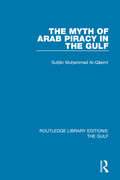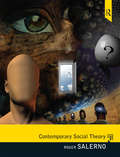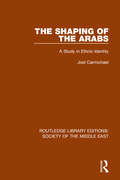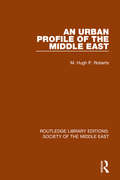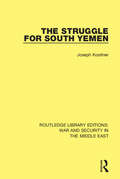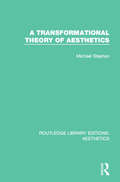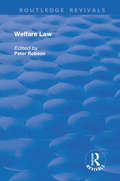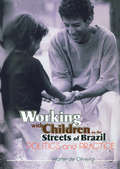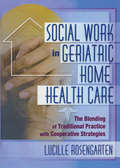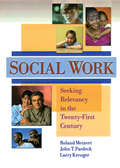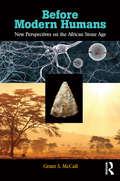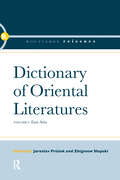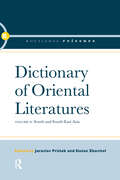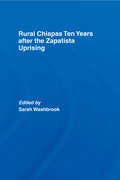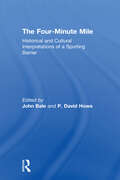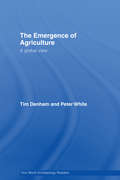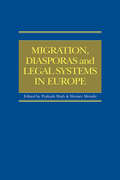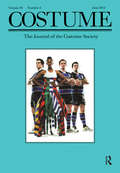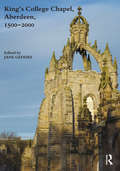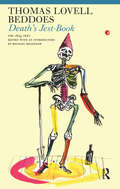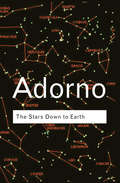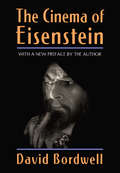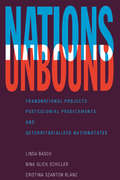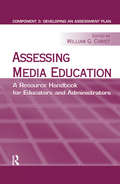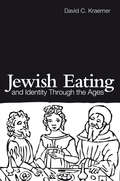- Table View
- List View
The Myth of Arab Piracy in the Gulf
by Muhammad Al-QasimiThe British became the dominant power in the Arab Gulf in the late eighteenth century. The conventional view has justified British imperial expansion in the Gulf region because of the need to supress Arab piracy. This book, first published in 1988, challenges the myth of piracy and argues that its threat was created by the East India Company for commercial reasons. The Company was determined to increase its share of Gulf trade with India at the expense of the native Arab traders, especially the Qawasim of the lower Gulf. However, the Company did not possess the necessary warships and needed to persuade the British Government to commit the Royal Navy to achieve this dominance. Accordingly the East India Company orchestrated a campaign to misrepresent the Qawasim as pirates who threatened all maritime activity in the northern Indian Ocean and adjacent waters. Any misfortune that happened to any ship in the area was attributed to the ‘Joasmee pirates’. This campaign was to lead eventually to the storming of Ras al-Khaimah and the destruction of the Qawasim. Based on extensive use of the Bombay Archives, previously unused by researchers, this book provides a thorough reinterpretation of a vital period in Gulf history. It also illuminates the style and method of the East India Company at a critical period in the expansion of the British Empire.
Contemporary Social Theory
by Roger SalernoContemporary Social Theory helps students explore, describe, and discuss how social theory relates to their own experiences, popular culture, and the world in which they live. It advances the view that new theory can be effectively used to assess social and cultural phenomena. The text identifies the important intellectual movements, categories, and paradigms that have occurred in the study of social theory. It also looks at issues closely related to contemporary social theory, such as: the postmodern condition, globalization, postcolonialism, inequality, gender, race, and human sexuality.
The Shaping of the Arabs: A Study in Ethnic Identity
by Joel CarmichaelThis book, first published in 1969, brings out clearly and concisely the complex moulding of Arab identity. The present-day Arabic-speaking peoples may be traced back to the Arabian tribes that were later to be shaped into a people by Islam. With the Muslim conquests the language of the Arabian tribes became the vernacular of a vast cosmopolitan society extending throughout the Middle East and Southern Mediterranean.
An Urban Profile of the Middle East
by Hugh RobertsChanges in economic and social conditions throughout the Middle East have been profound, and perhaps nowhere has this been more evident than in the field of urban development and town planning. This book, first published in 1979, provides a view of the Middle East as it undergoes transition by identifying and analysing the symptoms of change.
The Struggle for South Yemen
by Joseph KostinerSouth Yemen was long a key spot in the strategic geography of the West. Before the Second World War, it was important for the British as an outpost on the way to India. From the mid-1940s it was a crucial gateway to the oil rich Arabian Peninsular and a vital area in the context of superpower rivalry. This book, first published in 1984, traces the development of nationalist sentiment in South Yemen and the emergence of the two main groups in the struggle for independence: the NLF and FLOSY. Analysing both the impact of these groups on Yemeni society and demonstrating how they struggled with each other for supremacy, the book provides an perceptive account of how the revolutionary process in an Arab country unfolded.
A Transformation Theory of Aesthetics
by Michael StephanThis book develops a theory of picture perception and aesthetic response, arguing that images can generate in us a complex pattern of mental changes, or transformations. It is essential reading to those seriously involved in linking the arts and cognitive sciences.
Welfare Law
by Peter RobsonThis title was first published in 2001: Welfare law is a legal field integral to most jurisprudential formulations, whether artificially designated as doctrinal, theoretical or practical. At its core, legal discourse regarding welfare challenges the formulations traditionally viewed as ’pre-legal’, the ’background rules’ of property, tort and contract law. In addition, it affects a large percentage of the world’s population, highlights the social construction of identities and perhaps more than any other area of law, graphically epitomizes the intersection of class, race and gender distinctions. However, within both the legal academy and practice, welfare law has been marginalized and viewed as a field that does not connect to any but a small sector of lawyers and legal clients. Isolated as an arcane domain of either statutory and regulatory legal minutiae or jurisprudential insignificance, welfare law has never realized its potential as a major hub for legal theoretical discourse. The articles in this volume seek to expose the roots of the essentialized view of welfare law as nonessential and re-establish its value and importance.
Working with Children on the Streets of Brazil: Politics and Practice
by Walter de OliveiraReaffirm your political and spiritual commitment to helping the poor and oppressed!How can teachers and social workers reach the endangered kids who seldom come to school? By going to the streets, where the children live, work, fight, steal, get sick, sell their bodies, and all too often die. Working with Children on the Streets of Brazil is an in-depth study of Brazil's homeless children and the street youthworkers who offer them food, clothing, beds, hope, medical attention, education, and simple respect.The street children of Brazil live in unimaginable poverty and squalor, stealing jewelry or selling their bodies to survive, wandering homeless and untaught, pursued by death squads who clean up the streets by washing them with blood. Yet the street youthworkers interviewed in this moving, powerful book--some inspired by the Catholic Church's Liberation Theology movement, some employed by the government or private agencies--continue their efforts to help and heal these children, often with remarkable success. Their work is widely respected, and their unique viewpoint on serving throwaway children can offer creative solutions for social service workers around the globe.Many of the issues discussed in Working with Children on the Streets of Brazil will be painfully familiar to social service workers everywhere, including: the problems of how to identify, classify, and count the children of the streets the reasons children leave or lose their homes the implications of policy decisions and socioeconomic forces on the children's lives the clash between law-and-order advocates and social service professionals the negative effects of deinstitutionalization and overcrowded youth homes the tragic societal consequences of the widening gap between rich and poor the problems of youth crime and violence the difficulties in delivering education, health care, and basic services for homeless childrenThis impressive book offers a detailed history of the development of street social education; a study of the aims, methods, and experiences of youthworkers; and solid advice on using the principles and practices of street social education to reach the at-risk youth of any country, including the United States. Working with Children on the Streets of Brazil is both a scholarly work on the phenomenon of homeless children and a rousing call to action that will remind you of the reasons you chose to work in social services.
Social Work in Geriatric Home Health Care: The Blending of Traditional Practice with Cooperative Strategies
by Lucille RosengartenExplore how community-based networks can effectively meet the needs and problems of sick, elderly people and their caregivers!Social Work in Geriatric Home Health Care: The Blending of Traditional Practice with Cooperative Strategies explores how social workers, aides, nurses, administrators, and policy makers can cooperatively work by maintaining appropriate health records in order to keep the elderly living at home. Based on the author’s twenty-five years of social work experience in geriatric home care case management, this book explores improved ways to organize home health care by use of cooperative strategies in order to assist older individuals in living independent lives at home. Complete with informative case studies and interviews, you will explore useful examples of geriatric social work practice through Concerned Home Managers for the Elderly, (COHME) a nonprofit, licensed home health care agency. Social Work in Geriatric Home Health Care examines many crucial geriatric care and case management issues of concern to geriatric social workers, including:offering meaningful and fulfilling work as a home health care aideproviding high-quality training and ongoing education for home care aidescreating a cooperative environment by encouraging staff, social workers, and nurses to share expertise with the case management coordinators who are responsible for placing the geriatric patient at home or in a special care facilityinvolving the client in the management of his or her own health carecreating concise, one-page reports for each home visit by using a “One-Sheet” to help you extract case assessments and plans for your geriatric client in a readily accessible formatdealing with state regulatory authorities and the general trend in home health care to place the elderly in nursing homespaying careful attention to financial and administrative problems within your organization while striving to remain true to your original mission of providing at-home careSocial Work in Geriatric Home Health Care will help you explore a different way of organizing home health care for the sick and elderly at a time when the percentage of people over sixty-five who will require care is rapidly increasing. This important book works to improve the case management of geriatric people and challenges home health care workers and legislators to become more progressive in their thinking about the direction in which geriatric health care should move at the turn of the century. With this vital book, you will gain insight into organized and cooperative methods of providing home health care for the elderly and find improved methods for managing your geriatric cases to give your clients optimum care.
Social Work: Seeking Relevancy in the Twenty-First Century
by Jean A Pardeck Roland Meinert Larry W KreugerDiscover why social work must be restructured if it is to remain viable!Social Work: Seeking Relevancy in the Twenty-First Century provides you with a critical examination of the major issues that social work education and practice must confront if social work is to remain as a mainline profession. The book explores issues that are not normally covered in social work literature, such as the challenge of reconstructing the social work profession, the use of technology in social work, and the tension surrounding various social work education curriculums. You will benefit from this thorough discussion of the many problems that the social work profession is facing: a lack of scholarly research, inadequate educational programs, and the use of hypertechnology to educate social work students.Social Work: Seeking Relevancy in the Twenty-First Century examines the epistemological, theoretical, socio/technical, and practice directions that social work has branched into. You'll discover that today's central direction for social work is generated from liberal, postmodern, and increasingly feminist ideological perspectives. In a field where conceptual and theoretical input rarely allow for intellectual diversity, this volume demonstrates that several views are best for inquiry and exploration in social work.Issues discussed include: examining real or unreal social work values by separating them from beliefs, preferences, norms, attitudes, and opinions creating social work course outlines that incorporate practices developed around the globe, allowing for more conceptual and theoretical growth within the field realizing the tremendous difference between communication in the instrumental sense via technology, and in the affective, soul-oriented sense via personal interaction investigating the negative effects of communicating with hypertechnology (modems, e-mail) in the social work profession realizing the need for a greater quantity and quality of social work research to progress further in the fieldSocial Work: Seeking Relevancy in the Twenty-First Century invites you to reinvent social work for today's post-industrial and post-modern era. You will discover a series of challenges that social work must meet and overcome if it is to move into the new century as a relevant and viable profession. You will explore solutions such as increasing scholarship and research among social workers, and decreasing the use of technology (for example, classes held via the Internet) in social work education programs in order to increase the quality of the social work profession.
Before Modern Humans: New Perspectives on the African Stone Age
by Grant S. McCallThis fascinating volume, assessing Lower and Middle Pleistocene African prehistory, argues that the onset of the Middle Stone Age marks the origins of landscape use patterns resembling those of modern human foragers. Inaugurating a paradigm shift in our understanding of modern human behavior, Grant McCall argues that this transition—related to the origins of “home base” residential site use—occurred in mosaic fashion over the course of hundreds of thousands of years. He concludes by proposing a model of brain evolution driven by increasing subsistence diversity and intensity against the backdrop of larger populations and Pleistocene environmental unpredictability. McCall argues that human brain size did not arise to support the complex patterns of social behavior that pervade our lives today, but instead large human brains were co-opted for these purposes relatively late in prehistory, accounting for the striking archaeological record of the Upper Pleistocene.
Dictionary of Oriental Literatures 1: East Asia
by Jaroslav Průšek Zbigniew SłupskiThe Dictionary of Oriental Literatures fills a long-felt gap in Western literature by presenting a concise summary, in three volumes and about 2000 articles, of practically all the literatures of Asia and North Africa. The first volume describes the Chinese, Tibetan, Japanese, Korean and Mongolian literatures; the second covers the area of South and South-East Asia, comprising, besides all literatures of India and Pakistan, those of Nepal, Bangladesh, Sri Lanka, Myanmar, Thailand, Cambodia, Vietnam, Indonesia, Malaysia and the Philippines; and the third is devoted to the numerous literatures of West Asia and North Africa. including on the one hand the literatures of the ancient Near East and Egypt, and on the other hand those of Central Asia and the Caucasus, of Turkey, Iran, Afghanistan and of the various Arab countries including Morocco, Tunisia and Algeria. The majority of entries give information about the life and work of the individual writers and poets of the classical, medieval and modern periods of the literatures included and also attempt to evaluate their writings from the historical and aesthetic point of view. The remaining articles describe literary terms, genres, forms, schools, movements etc. The Dictionary has been prepared by the Oriental Institute in Prague under the supervision of a Advisory Editorial Board of European and American scholars of international reputation and is unique in that it is the fruit of the collaboration of over 150 orientalists from many parts of the world. Contents include: Volume I East Asia: The Far East, including Chinese, Tibetan, Japanese, Korean and Mongolian literatures. Volume II South and South-East Asia: Ancient Indian, Assamese, Baluchi, Bengali, Gujarati, Hindi, Indian literature in English, Indo-Persian, Kannada, Kashmiri, Maithili, Malayalam, Marathi, Oriya, Panjabi, Pashto, Rajasthani, Sindhi, Tamil, Telugu and Urdu, Sinhalese, Nepali, Burmese, Thai, Cambodian, Malay and Indonesian, Javanese, Vietnamese and Philippines literatures. Volume III West Asia and North Africa: The Near East and Egypt, Central Asia and the Caucasus, Turkish, Persian, Afghan, Kurd and Arabic literatures, covering all the Arab states from Iraq in the East to Algeria in the West.
Dictionary of Oriental Literatures 2: South and SE Asia
by Jaroslav Pru̇šek Dušan ZbavitelThis book fills a long-felt gap in Western literature by presenting a concise summary of practically all the literatures of South and South-East Asia, comprising India, Pakistan, Nepal, Bangladesh, Sri Lanka, Myanmar, Thailand, Combodia, Vietnam, Indonesia, Malaysia, and the Philippines.
Rural Chiapas Ten Years after the Zapatista Uprising
by Sarah WashbrookConsidered the most significant recent agrarian movement in Mexico, the 1994 EZLN uprising by the indigenous peasantry of Chiapas attracted world attention. Timed to coincide with the signing of the NAFTA agreement, the Zapatista Army of National Liberation reasserted the value of indigenous culture and opposed the spread of neo-liberalism associated with globalization. The essays in this collection examine the background to the 1994 uprising, together with the reasons for this, and also the developments in Chiapas and Mexico in the years since. Among the issues covered are the history of land reform in the region, the role of peasant and religious organizations in constructing a new politics of identity, the participation in the rebellion of indigenous women and changing gender relations, plus the impact of the Zapatistas on Mexican democracy. The international group of scholars contributing to the volume include Sarah Washbrook, George and Jane Collier, Antonio García de León, Daniel Villafuerte Solís, Gemma van der Haar, Mercedes Olivera, Marco Estrada Saavedra, Heidi Moksnes, Neil Harvey, and Tom Brass.This book was previously published as a special issue of The Journal of Peasant Studies.
The Four-Minute Mile: Historical and Cultural Interpretations of a Sporting Barrier
by John BaleBreaking records and challenging the limits of human ability are central to much of our understanding of athletic track and field sports, with a world record title arguably as valued as an Olympic gold medal. Some particular limits and records take on greater significance, however, as in the case of the Four-Minute Mile which was roundly believed to be impossible until Roger Bannister shattered the illusion with half a second to spare in May 1954. These essays look at the background of Bannister’s achievement and the meaning that was ascribed to it by the media and the public at large, drawing on an array of interdisciplinary and international influences to unpick the legend surrounding an historic moment in our social and sporting past.
The Emergence of Agriculture: A Global View (One World Archaeology)
by Tim DenhamThis volume, the first in the One World Archaeology series, is a compendium of key papers by leaders in the field of the emergence of agriculture in different parts of the world. Each is supplemented by a review of developments in the field since its publication. Contributions cover the better known regions of early and independent agricultural development, such as Southwest Asia and the Americas, as well as lesser known locales, such as Africa and New Guinea. Other contributions examine the dispersal of agricultural practices into a region, such as India and Japan, and how introduced crops became incorporated into pre-existing forms of food production.This reader is intended for students of the archaeology of agriculture, and will also prove a valuable and handy resource for scholars and researchers in the area.
Migration, Diasporas and Legal Systems in Europe
by Prakash Shah and Werner F. MenskiAt a time when issues concerning migration and the formation of diasporic communities have come to be critical for all European legal systems, this volume reflects, discusses and analyzes the questions raised by diasporas who have established themselves in Europe over more than fifty years of immigration and the challenges faced by legal systems in the light of continued migration. Contributors from a broad range of backgrounds address prominent issues ranging from legal pluralism among minorities, pressures on EU accession states, irregular migration, state control of family reunification and formation in light of human rights laws, challenges for citizenship and nationality laws and the implementation of visa rules and juxtaposed control zones. Besides the EU as a supranational legal order, the book contains discussion of conditions in the United Kingdom, Ireland, France, Spain, Gibraltar, Morocco, Greece, Turkey and Lithuania.This volume accompanies The Challenge of Asylum to Legal Systems and is the second book to emerge from the W.G Hart Legal Workshop held in 2004 at London's Institute for Advanced Legal Studies.
Costume: A Volume for the London Olympics
by The Costume SocietyThis volume, consisting of papers originally delivered at the Sport and Fashion symposium in 2011, celebrates the connection between sport and the clothes and fashion which are associated with certain sporting activities. Articles include a study of Olympic swimming costumes, women's sport during the inter-war period, the use of sportsmen by clothing industries for brand marketing, and the aesthetic significance of certain items of clothing, specifically the shirt worn by Maradona during the 1986 Argentina-England World Cup quarter final. For more information, visit: www.maney.co.uk/journals/cos
King's College Chapel, Aberdeen, 1500-2000
by Jane GeddesThis new edition is a revised and expanded version of the book produced in 2000 to celebrate the quincentenary of King's College Chapel, Aberdeen. Since then, exciting discoveries have taken place and old ideas have been reappraised. The choir stalls and woodwork have provided a fresh seam of information about the meaning and use of the medieval chapel. Daniel MacCannell has identified new iconography in the stalls. Jane Geddes, prompted by the installation of the new organ, has investigated the original function and appearance of the great pulpitum or screen between the choir and nave and discovered the location of a magnificent lost organ loft. Mary Pryor and John Morrison have examined the great baroque biblical paintings and come up with a totally new interpretation of their iconography and function: a political warning to King Charles II. Easter Smart, the university chaplain, describes the flexible and ecumenical use of the chapel today. The revised edition appears in time to honour the quincentenary of the death of Bishop William Elphinstone, the founder of Aberdeen University, who died in 1514. This book aims to integrate his legacy to the chapel: the liturgy, music, architecture and fittings. Thanks to an unusually tolerant and conservative attitude towards religion at the university following the Reformation, the chapel has survived in a more complete medieval state than any other church in Scotland. The rich archive of university documents show how benign neglect and a fierce pride in their iconic building caused the university to maintain the structure and its furnishings even during the long centuries when it ceased to serve a religious function.
Death's Jest Book: The 1829 Text (Fyfield Bks.)
by Thomas Lovell BeddoesThis book is Thomas Lovell Beddoes's defining text, a pastiche Renaissance tragedy replete with treachery, murder, sorcery and haunting, the extravagant expression of the poet's lifelong obsession with mortality and immortality. It is a classic of the literature of death.
The Stars Down to Earth (Routledge Classics)
by Theodor AdornoThe Stars Down to Earth shows us a stunningly prescient Adorno. Haunted by the ugly side of American culture industries he used the different angles provided by each of these three essays to showcase the dangers inherent in modern obsessions with consumption. He engages with some of his most enduring themes in this seminal collection, focusing on the irrational in mass culture - from astrology to new age cults, from anti-semitism to the power of neo-fascist propaganda. He points out that the modern state and market forces serve the interest of capital in its basic form. Stephan Crook's introduction grounds Adorno's arguments firmly in the present where extreme religious and political organizations are commonplace - so commonplace in fact that often we deem them unworthy of our attention. Half a century ago Theodore Adorno not only recognised the dangers, but proclaimed them loudly. We did not listen then. Maybe it is not too late to listen now.
The Cinema of Eisenstein
by David BordwellThe Cinema of Eisenstein is David Bordwell's comprehensive analysis of the films of Sergei Eisenstein, arguably the key figure in the entire history of film. The director of such classics as Potemkin, Ivan the Terrible, October, Strike, and Alexander Nevsky, Eisenstein theorized montage, presented Soviet realism to the world, and mastered the concept of film epic. Comprehensive, authoritative, and illustrated throughout, this classic work deserves to be on the shelf of every serious student of cinema.
Nations Unbound: Transnational Projects, Postcolonial Predicaments and Deterritorialized Nation-States
by Linda Basch Nina Glick Schiller Cristina Szanton BlancNations Unbound is a pioneering study of an increasing trend in migration-transnationalism. Immigrants are no longer rooted in one location. By building transnational social networks, economic alliances and political ideologies, they are able to cross the geographic and cultural boundaries of both their countries of origin and of settlement. Through ethnographic studies of immigrant populations, the authors demonstrate that transnationalism is something other than expanded nationalism. By placing immigrants in a limbo between settler and visitor, transnationalism challenges the concepts of citizenship and of nationhood itself.
Assessing Media Education: A Resource Handbook for Educators and Administrators: Component 3: Developing an Assessment Plan (Routledge Communication Ser.)
by William G. ChristThe chapters in this component of Assessing Media Education are valuable for those who need to know how to develop an assessment plan.
Jewish Eating and Identity Through the Ages (Routledge Advances In Sociology Ser.)
by David C. KraemerThis book explores the history of Jewish eating and Jewish identity, from the Bible to the present. The lessons of this book rest squarely on the much-quoted insight: 'you are what you eat.' But this book goes beyond that simple truism to recognise that you are not only what you eat, but also how, when, where and with whom you eat. This book begins at the beginning – with the Torah – and then follows the history of Jewish eating until the modern age and even into our own day. Along the way, it travels from Jewish homes in the Holy Land and Babylonia (Iraq) to France and Spain and Italy, then to Germany and Poland and finally to the United States of America. It looks at significant developments in Jewish eating in all ages: in the ancient Near East and Persia, in the Classical age, throughout the Middle Ages and into Modernity. It pays careful attention to Jewish eating laws (halakha) in each time and place, but it does not stop there: it also looks for Jews who bend and break the law, who eat like Romans or Christians regardless of the law and who develop their own hybrid customs according to their own 'laws', whatever Jewish tradition might tell them. In this colourful history of Jewish eating, we get more than a taste of how expressive and crucial eating choices have always been.
